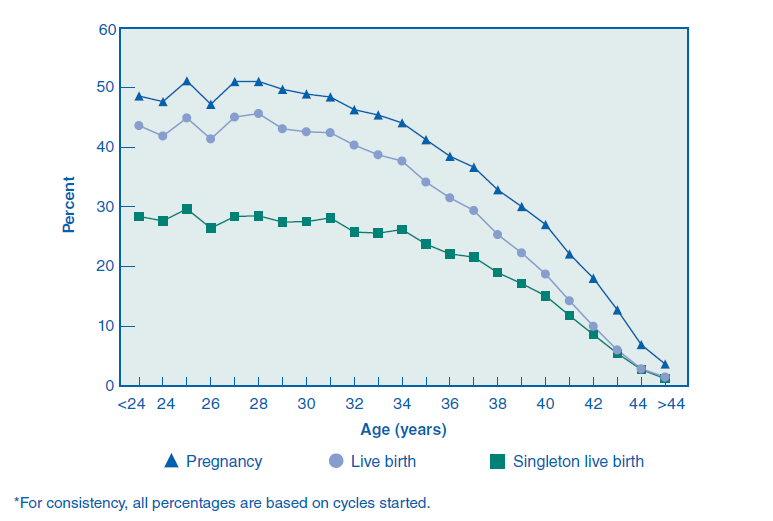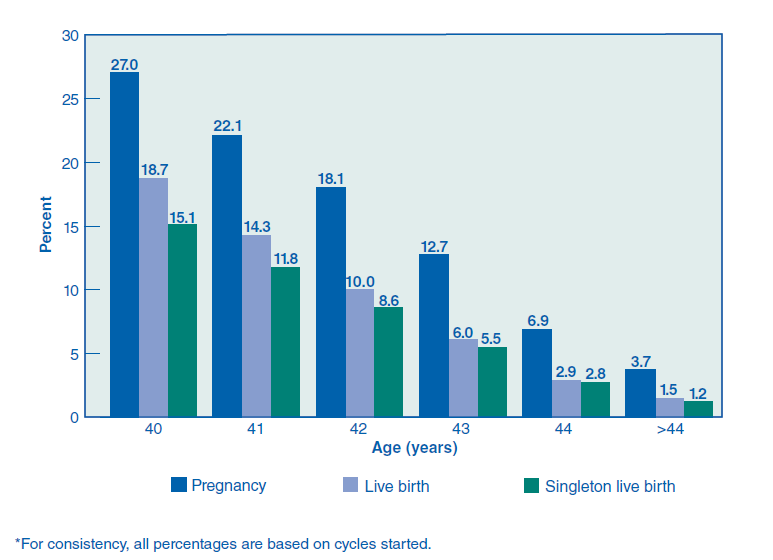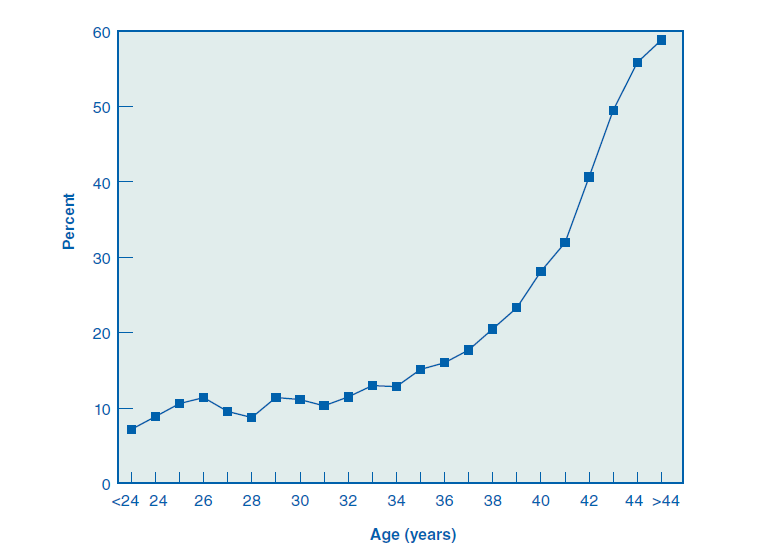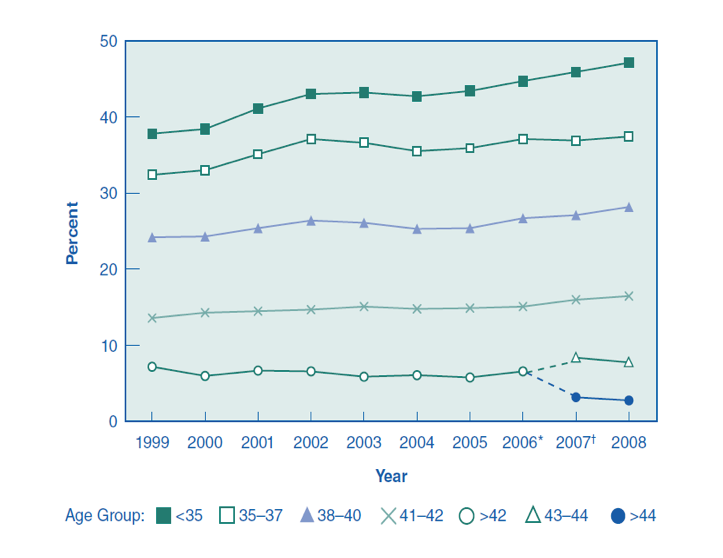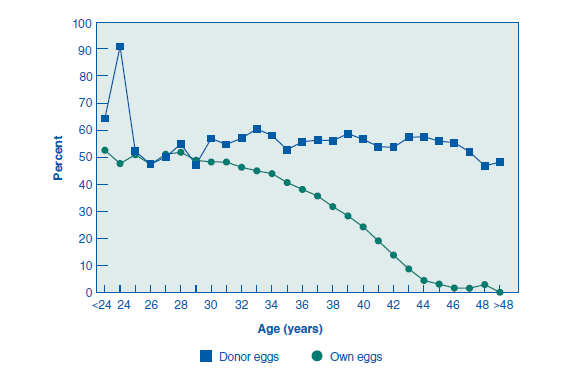Recipients: who can benefit?
Egg donation is often the last resort in infertility treatment, but it provides very high chances even if all other forms of fertility treatment may not be promising. It is often used when other fertility procedures such as IVF have failed. It has enabled many women in their late thirties and forties to become a mother at a time when their own eggs are no longer healthy enough to create a pregnancy. Egg donation (or ovum donation), is an increasingly popular method of fertility treatment. It has high success rates, particularly when the eggs come from young, healthy and fertile donors. For childless women in their late thirties and forties, it often offers the best chance of becoming a mother.
A premature menopause
Normally, the menopause starts between the ages of 46 and 50, but for some women it occurs in their thirties or even in their twenties. One of the most cruel effects of a premature menopause is its result on fertility. Women who suffer a premature menopause are often devastated to discover that they cannot become pregnant in the normal way because they have no eggs left. This is an additional blow on top of the unpleasant menopausal symptoms which these women have to bear. Fortunately though, the majority of women who experience a premature menopause still have a uterus capable of carrying a child (after being properly medically prepared). They can therefore use egg donation to achieve a pregnancy, carry a baby to term and welcome a healthy child into their arms.
Failed fertility treatments
Many egg donation patients have already undergone years of fertility investigations and treatment, such as repeated IVF procedures which have not worked. Sadly, this often indicates that the reason for infertility lies with the quality of the patient’s eggs. For instance, although some women are able to create embryos in the laboratory, these unfortunately do not implant or survive. Unfortunately, problems such as these tend to get worse as the woman grows older. With the march of time, the number and quality of eggs in the ovaries naturally both decrease. It therefore becomes increasingly hard to get pregnant by using your own eggs as time goes on, even with medical procedures such as IVF. Although assisted reproduction procedures such as IVF can help many couples conceive, there will always be a number of patients who do not get pregnant even after multiple normal IVF or ICSI treatments. In these cases, egg donation helps them to overcome their infertility and become parents of a healthy baby.
Certain medical conditions
There are a number of serious medical conditions which may result in infertility. For example, if a woman has been treated for cancer, chemotherapy may make her infertile. Medical treatment with X-ray therapy, or abdominal surgery, can also result in serious side-effect of infertility. Even though modern-day treatments of cancer ensure high survival rates, patients in these categories may no longer be able to have a child by using their own eggs. However, they will be just as interested in pregnancy and motherhood as any other women. Egg donation may therefore be the only means of achieving a pregnancy in these patients.
If you are under 40 and unluckily face the need for chemo- or radiotherapy, please look at the option of freezing your own eggs prior to starting your cancer treatment. The most modern method of egg freezing – called vitrification – provides very good egg survival, fertilisation and pregnancy rates. Even if after your cancer treatment, you have a premature menopause and so do not have any eggs left in your ovaries, you can still get pregnant with your own frozen eggs. In 2011-2012 the AVA-Peter Clinic has established an effective egg freezing procedure.
Hereditary conditions
If there is a severe genetic disease in a woman’s family, she may choose to have a child via egg donation in order to avoid the risk of passing on this condition to her baby. As children bear the genes of their genetic parents, those born via egg donation will bear the genes of their genetic father (who could be a partner or a sperm donor), and the egg donor. Although the egg recipient will carry the baby during the pregnancy, there is no risk of passing the genetic disease on to the child during pregnancy. And although there is no genetic link between the mother and the baby, the pregnancy can develop very successfully. Once the baby is born, the egg recipient is legally the mother, and the baby will definitely regard you as its mother!
Down’s Syndrome
The risk of bearing a child with Down’s Syndrome increases hugely when the egg originates from an older woman. For this reason, a number of older women prefer to minimise this risk by using eggs from a young egg donor. When calculating the risk of a Down’s child, it is the egg donor’s age that counts, not the age of the expectant mother. This is another reason why I recommend only using eggs from young donors, and ensure that only young egg donors are recruited. They are all under the age of 30, and their average age is just 26.
Advanced reproductive age
As women age, the number and quality of eggs in their ovaries go down until there are no healthy eggs left. It therefore becomes increasingly hard to get pregnant the natural way or even with medical procedures such as IVF. Embryos created by using eggs from women older than 40 have a very low chance of developing until the live birth stage due to multiple spontaneous chromosome defects that eggs acquire with the flow of time. The percentage of eggs with such spontaneous chromosome defects increases with the woman’s age, slowly after 35 and enormously after 40. Although assisted reproduction procedures such as IVF or ICSI can help many couples to become pregnant, these have a much reduced success rate when the female partner is older.
Figure 2: Success rates by age for women using their own eggs in IVF treatment
Figure 2. Percentages of IVF Cycles Using Fresh Non-donor Eggs or Embryos That Resulted in Pregnancies, Live Births, and Singleton Live Births, by Age of Woman, 2009 (American national summary on assisted reproductive technology success rates. National Center for Chronic Disease Prevention and Health Promotion, December 2011)
Your chances of success using your own eggs in IVF treatment
As you can see from the statistics in Figure 2, the percentages of started IVF cycles that result in pregnancies and live births decline with each year of age and are particularly low for women aged 40 or older. Figure 3 shows the percentages of IVF cycles started in 2009 in the USA that resulted in pregnancies and live births for women aged 40 or older who used their own fresh eggs or embryos. The average chance for pregnancy and live birth per IVF cycle started was about 27% and 18,7% respectively for women aged 40. All percentages dropped steadily with each 1-year increase in age. So for women who were 43 years of age, 12,7% of IVF cycles resulted in pregnancy, but the percentage of IVF cycles resulting in live births for this age group was only about 6%. For women older than 44, the percentage of live births was close to 1%. Please note that the statistical data presented relates to American practices, in which usually more than 2 embryos are transferred into the uterus for women of advanced reproductive age. In other words, the success rates shown in Figure 2 and Figure 3 are the maximum chances under the most optimistic form of treatment.
Women aged 40 or older generally have much higher chance of a live birth using donor eggs than when using their own eggs.
Figure 3: Success rates for women over 40 using their own eggs in IVF treatment
Figure 3 Percentages of IVF Cycles Using Fresh Non-donor Eggs or Embryos That Resulted in Pregnancies, Live Births, and Singleton Live Births Among Women
Aged 40 or Older*, 2009
(American national summary on assisted reproductive technology success rates. National Center for Chronic Disease Prevention and Health Promotion, December 2011)
The risk of miscarriage
A woman’s age when her own eggs are used not only affects her chance of pregnancy, but also her risk of miscarriage. Figure 4 shows the percentages of IVF cycles started in 2009 in the USA that resulted in miscarriage for women of different ages. The percentage of “own egg” IVF cycles that resulted in miscarriage was below 13% among women younger than 35. The percentage of “own egg” IVF cycles that resulted in miscarriage began to increase among women in their mid to late 30s and continued to increase with age, reaching 28% at age 40 and almost 59% among women older than 44.The risk of miscarriage observed among women undergoing IVF procedures using fresh “own eggs or embryos” appears to be similar to those reported in various studies of other pregnant women in the United States. In other words, whether you get pregnant by using your own eggs, either naturally or via IVF, the risk of miscarriage is the same.
Figure 4:Miscarriage rates for women using their own eggs in IVF treatment
Figure 4 Percentages of IVF Cycles Using Fresh Non-donor Eggs or Embryos That Resulted in Miscarriage, by Age of Woman, 2009
(American national summary on assisted reproductive technology success rates. National Center for Chronic Disease Prevention and Health Promotion, December 2011)
It is sadly clear that even though the constant development of IVF techniques within the last 10 years has resulted in higher live birth rates after IVF or ICSI in younger age groups, the chances of having a baby remain consistently low for women over 42. (See Figure 5).
Figure 5: Percentage of live birth rates by age of women using their own eggs in IVF treatment
Figure 5. Percentages of Transfers That Resulted in Live Births for ART Cycles Using Fresh Non-donor Eggs or Embryos, by Age of Woman, 1999–2008
(American national summary on assisted reproductive technology success rates. National Center for Chronic Disease Prevention and Health Promotion, December 2010)
As the chances of achieving a live birth are so low for older women, many fertility clinics in Europe refuse to even offer IVF treatment to women over 42. However, worldwide studies and my own experience have shown conclusively that women in their late thirties and throughout their forties can still carry a pregnancy and give birth to a healthy child, as long as they have a uterus, their general health is good and donor eggs from a younger woman are used. Egg donation therefore still remains the most effective option for women of advanced reproductive age. In such cases, treatment with healthy donor eggs can provide a very good chance of success (Figure1).
Why use egg donation?
When other fertility treatments such as IUI and IVF have repeatedly failed, egg donation can be your best chance of having a child. This is especially true for women of advanced reproductive age, for whom IVF using their own eggs has a very low success rate. At the age of 40, the average live birth rate for one own egg fresh embryo transfer is about 20%. This drops to 13% for women aged 42, and 5% for women aged 44. By the age of 46, the chance of live birth per one fresh embryo transfer using your own eggs is sadly around 1% (see Figure 1). Please note that this is the maximum possible success rate as it relates to more than 2 embryos transferred per embryo transfer (American data).
Success rates: the statistics
In the graph below, you can see the difference between the live birth rates after egg donation IVF (in blue) compared with the live birth rates for women using their own eggs in IVF treatment (in green), calculated per one fresh embryo transfer. These figures show the percentages of embryo transfers that resulted in live births among women of different ages. It is clear that the likelihood of a fertilised egg implanting and resulting in a live birth is related to the age of the woman who produced the egg, not the age of the women in whom the embryo was implanted. The percentage of fresh embryo transfers resulting in live births for cycles using embryos from women’s own eggs declines as women get older. In contrast, since egg donors are typically in their 20s or early 30s, the percentage of transfers that results in live births for cycles using embryos from donor eggs remains consistently high at above 50% for most patients.
Figure 1: Success rates by age for egg donation and own egg IVF
Figure 1. Percentages of Transfers That Resulted in Live Births for Assisted Reproductive Technology (ART) Cycles Using Fresh Embryos from Own Eggs and ART Cycles Using Fresh Embryos from Donor Eggs, by Age of Woman, 2009. Reference: American national summary on assisted reproductive technology success rates, National Center for Chronic Disease Prevention and Health Promotion, December 2011. (Data from 84 039 embryo transfers with fresh non-donor eggs and 16 225 embryo transfers with fresh donor eggs )
It is therefore very possible for women throughout their forties to become pregnant and to have a healthy pregnancy and a healthy child using egg donation. In my 10 years of experience of carrying out egg donation treatment, I have come the same conclusion: as an egg donation recipient, you have the same high chance per attempt to become pregnant and have a baby whether you are aged 30 or 50.
Having now completed over 1400 fresh and frozen egg donation treatments over the past 9 years, which have resulted in the birth of more than 700 healthy children, I have also concluded that there are almost no “bad” or “unpromising” egg donation recipients. I believe that only if there are serious general health problems that make pregnancy inadvisable, or (very rarely) severe, untreatable conditions within the uterus or if there is no uterus at all, we have to say no to egg donation. In all other cases, we have proven methods and medications to enable us to prepare any egg donation recipient properly.
I also believe that each egg donor should be treated very attentively and individually to collect the highest-quality eggs!
How to improve the chances of success
One of main reasons why we are so successful in AVA-Peter is that the egg comes from a much younger donor than the would-be mother. The remarkable skills of the AVA-Peter’s embryological team and the up to date lab equipment allows to grow and choose the best quality embryos on day 5 in the very best way. By supporting the pregnancy with a course of hormones, we can help to ensure that the embryo implants and grows successfully.
Over the last few years, we have maintained a 60% clinical pregnancy rate and a 49% live birth rate in our donor egg recipients, calculated per transfer of 2 fresh embryos on day 5.
Even if you are in your late 40s and your general health is good, you can carry your pregnancy through to a live birth as successfully as a healthy 30-year-old woman. The average live birth weight in my 40 to 49-year-old patient group is 3300 g in singletons and 2650 g in twins.
I recommend only egg donors who are young and who have at least one child of their own for my patients. These donors tend to produce a pleasing number of high-quality eggs. That is why it is very easy for us to guarantee at least 10 donor eggs available for fertilization for each egg donation recipient at AVA-Peter. Our patients therefore have a high chance of success after fresh embryo transfer and are often able to freeze extra good-quality embryos after having one or two fresh embryos replaced. In 2010-2011, AVA-Peter successfully implemented the world’s most successful freezing procedure, which is called vitrification. 43% of frozen embryo transfers resulted in a clinical pregnancy (confirmed by ultrasound) in 2011-2012.
High success rates in egg donation can only be regularly achieved in clinics that have a high-quality IVF laboratory, ISO certification, young, healthy, fertile, medically screened donors who produce high-quality eggs, and that have an established track record in egg donation. Such clinics will have an experienced medical team and good facilities, and often operate 7 days per week. AVA-Peter is the only clinic in Russia that meets these standards.
